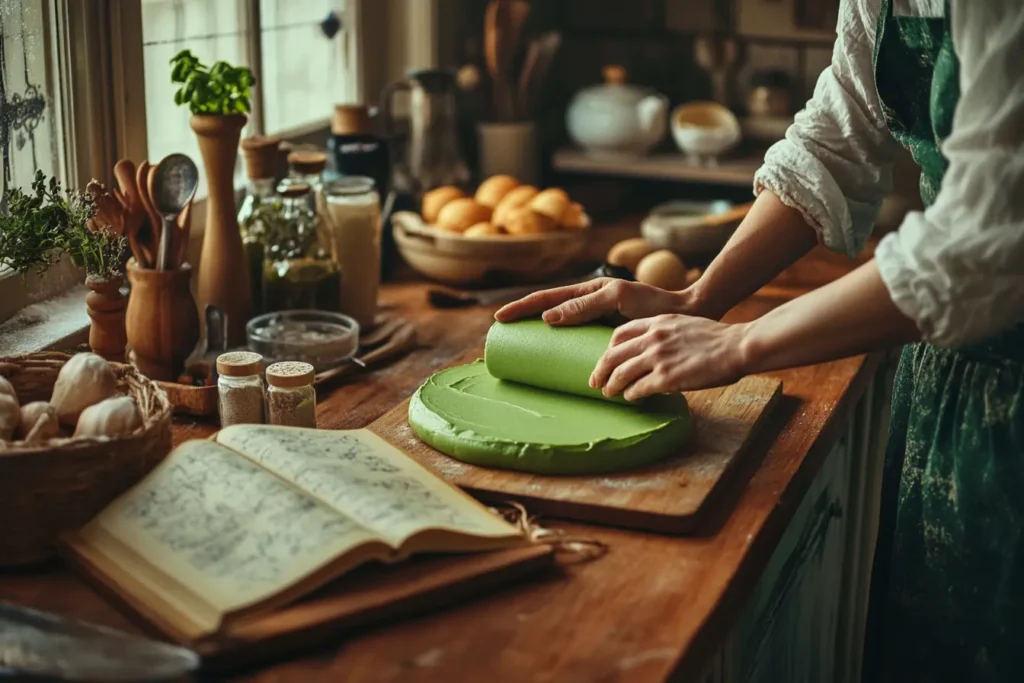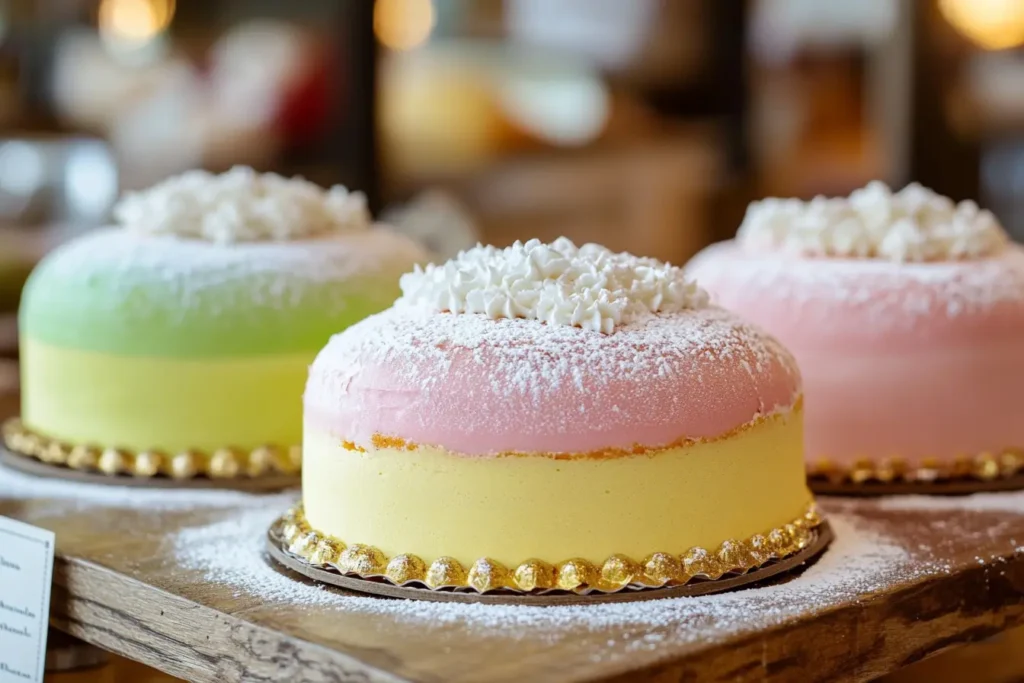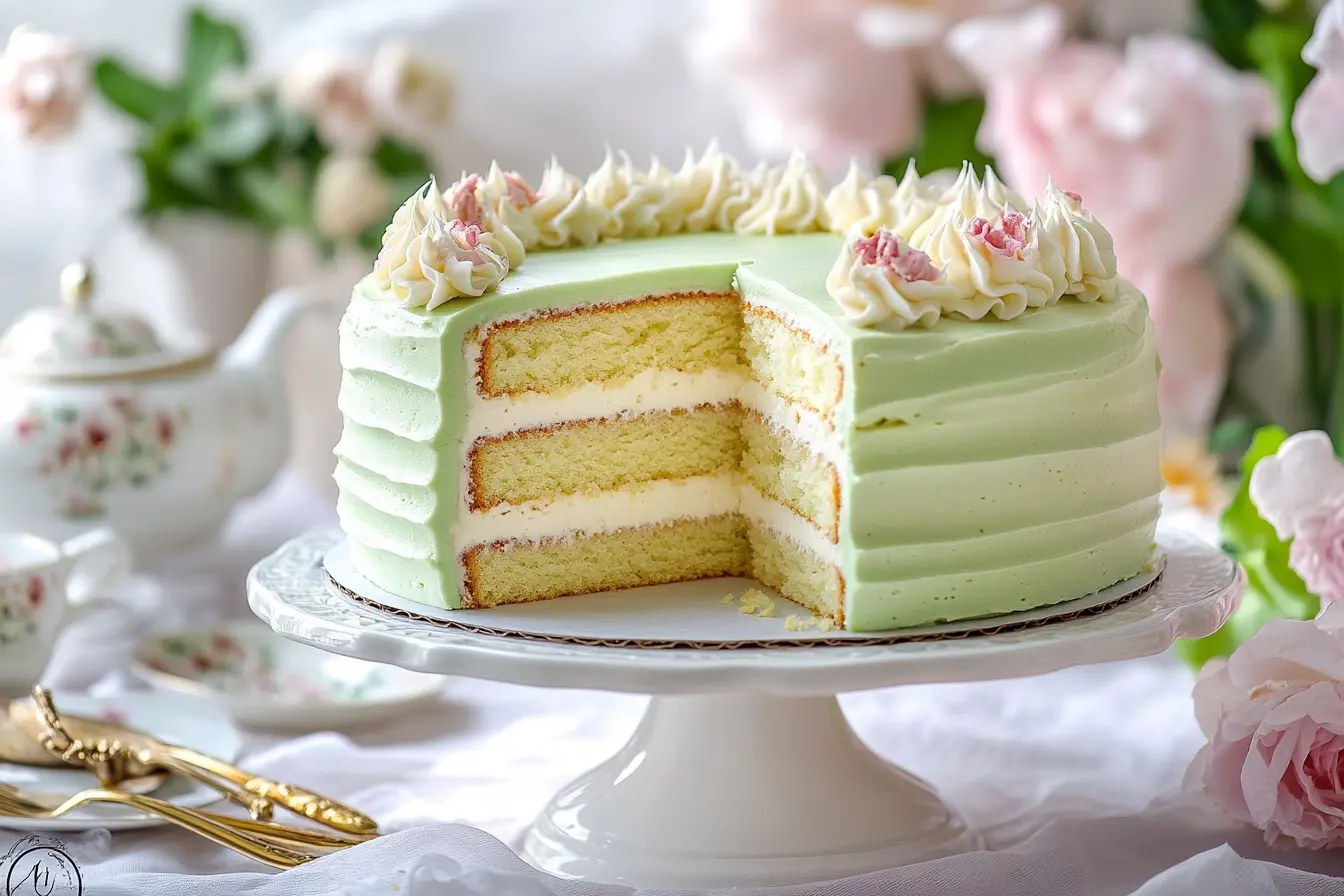If you’ve ever seen a Swedish Princess Cake (Prinsesstårta), you probably noticed its vibrant green marzipan topping. But why are princess cakes green? Is it just for looks, or does the color have a deeper meaning?
Princess cakes are one of Sweden’s most famous desserts, known for their soft sponge cake, rich pastry cream, fluffy whipped cream, and smooth marzipan covering. Originally called “Grön Tårta” (Green Cake), this royal treat was later renamed Prinsesstårta after the three Swedish princesses who adored it.
In this article, we’ll explore:
- The history of the green marzipan.
- Why green became the signature color of the cake.
- How this dessert became a Swedish national treasure.
Let’s dive into the sweet and colorful history behind this beloved cake!
Introduction to Princess Cakes
What Is a Princess Cake?
A Princess Cake, or Prinsesstårta, is a traditional Swedish dessert made with:
- Light sponge cake for a soft base.
- Vanilla pastry cream for a rich, silky texture.
- Whipped cream for an airy, delicate touch.
- A smooth marzipan layer, typically green, for a decorative finish.
Its rounded shape and elegant marzipan topping give it a regal look, making it a favorite for celebrations like birthdays, weddings, and Sweden’s National Princess Cake Week.
The Origin of the Green Color
But why are princess cakes green? The answer goes back to the early 1900s, when Jenny Åkerström, a Swedish home economics teacher, created the cake for Princess Margaretha, Princess Märtha, and Princess Astrid.
- At first, the cake was simply called “Grön Tårta” (Green Cake) because of its distinctive marzipan layer.
- The three princesses loved it so much that it was later renamed Prinsesstårta in their honor.
- The green color became a signature because it was unique, elegant, and visually appealing.
Unlike other cakes that use chocolate or fruit-based coverings, the smooth green marzipan gave Prinsesstårta a royal, distinctive look that made it stand out.
The History of the Green Marzipan
Who Created the Princess Cake?
To understand why are princess cakes green, we need to look at their royal origins.
The Swedish Princess Cake (Prinsesstårta) was first introduced in the early 1900s by Jenny Åkerström, a Swedish home economics teacher. She created the cake for three Swedish princesses—Margaretha, Märtha, and Astrid—who adored the delicate layers of sponge cake, whipped cream, and pastry cream.
- The cake was originally called “Grön Tårta” (Green Cake) due to its distinctive green marzipan covering.
- It was later renamed Prinsesstårta because the princesses loved it so much.
- Over time, it became a beloved tradition in Sweden, particularly during special celebrations and birthdays.
Why Was Green Chosen?
So, why did bakers make princess cakes green instead of another color? While the exact reason remains unclear, several theories explain this choice:
- Royal Elegance – Bakers viewed green as a sophisticated, noble color, making it perfect for a princess.
- Natural Ingredients – They originally used natural sources like spinach or pistachio paste to color the marzipan.
- Unique Appearance – Since most cakes featured chocolate or fruit glazes, bakers chose smooth green marzipan to make Prinsesstårta stand out.
The green marzipan quickly became a signature feature, setting this cake apart as one of Sweden’s most recognizable desserts.

How Princess Cakes Became a Cultural Icon
Sweden’s National Cake & Fika Culture
If you visit Sweden, you’ll likely come across Prinsesstårta in almost every bakery. But why is it so popular?
- The cake has become a symbol of Swedish culinary heritage.
- It’s a favorite treat during Fika, Sweden’s beloved coffee and cake tradition.
- Every year, Sweden celebrates Prinsesstårta Week in late September, where bakeries sell the cake in large quantities.
The green marzipan isn’t just a design choice—it’s a cultural icon that connects Swedes to their royal past.
Modern Adaptations & Different Colors
Even though the traditional princess cake is green, variations have emerged over the years:
- Pink Princess Cakes – Often made for weddings or Valentine’s Day.
- Yellow Princess Cakes – A bright twist, usually seen around Easter.
- White Princess Cakes – A minimalist, elegant version for formal occasions.
However, the green version remains the most famous because of its deep-rooted history and royal connections.
The Role of Marzipan in Princess Cakes
What Is Marzipan, and Why Is It Used?
One of the most recognizable features of a Swedish Princess Cake (Prinsesstårta) is its smooth green marzipan layer. But why marzipan? And why are princess cakes green instead of another color?
Marzipan, a mixture of ground almonds, sugar, and egg whites, has been a popular ingredient in European baking for centuries. It provides:
- A smooth, elegant finish that makes the cake look refined and professional.
- A mildly sweet, nutty flavor that complements the light sponge cake and creamy filling.
- A protective layer that helps keep the cake moist and fresh for longer.
Unlike fondant, which is commonly used in cake decorating, marzipan has a richer taste and a softer texture, making it a favorite for traditional European desserts.
How the Green Color Is Achieved
So, why are princess cakes green rather than white, yellow, or another pastel shade? The answer lies in how the marzipan is colored:
- Traditional Method: Early versions of Prinsesstårta used natural colorings like spinach extract or finely ground pistachios to create the iconic green shade.
- Modern Method: Today, food-safe green dye is typically added to marzipan to achieve a consistent, vibrant color.
While some bakeries still use natural colorants, most opt for food-grade dyes to maintain the cake’s classic look while ensuring consistency.
FAQs – What People Also Ask
Why Is the Princess Cake Traditionally Green?
The cake was originally called “Grön Tårta” (Green Cake), but bakers later renamed it Prinsesstårta. They chose the green marzipan to give the cake a unique, royal appearance that set it apart from other desserts.
Can Princess Cakes Be Made in Other Colors?
Yes! While green remains the most iconic, modern variations include:
- Pink princess cakes for special occasions like weddings or Valentine’s Day.
- Yellow princess cakes often made for Easter.
- White princess cakes for minimalist, elegant presentations.
Despite these variations, the green version remains the most well-known and widely loved.
What Does the Green Marzipan Taste Like?
The green marzipan covering has a sweet, nutty almond flavor. Some versions enhance it with vanilla or rose water for a more aromatic taste.
How Can You Make a Princess Cake at Home?
If you’re inspired to bake your own, here are some tips:
- Use high-quality marzipan for the best flavor and texture.
- Roll out the marzipan carefully to achieve a smooth, seamless finish.
- Chill the cake before decorating to help the layers stay intact.
For more detailed baking guides, check out our latest cake recipes and baking tips! 🎂✨

The Future of Princess Cakes – A Lasting Tradition
How Prinsesstårta Continues to Evolve
Even after more than a century, the Swedish Princess Cake (Prinsesstårta) remains a beloved dessert. But how has it evolved over time? And why are princess cakes green still, despite the rise of other variations?
While the traditional green marzipan version is the most famous, bakers have introduced new takes on the cake to keep it exciting:
- Mini Prinsesstårta – Smaller, individual-sized cakes perfect for single servings.
- Layered or Naked Princess Cakes – Some versions skip the marzipan entirely, focusing on the cream and sponge cake layers.
- Flavored Marzipan – Instead of classic almond marzipan, some bakeries offer pistachio, vanilla, or even chocolate-infused coatings.
Despite these modern adaptations, the green marzipan-covered Prinsesstårta remains the most popular, proving that its history, tradition, and elegance still captivate dessert lovers worldwide.
Why the Green Color Will Always Be a Signature
At this point, it’s natural to ask, why are princess cakes green and not another color as the standard? The answer lies in its branding, nostalgia, and cultural significance:
- Swedish Identity – Prinsesstårta has become a national symbol, often associated with Swedish celebrations.
- Instant Recognition – The green color makes the cake stand out, making it easily recognizable even outside Sweden.
- Time-Honored Tradition – The original recipe has been passed down for generations, and changing the color too much would take away its historical charm.
Because of these reasons, the classic green Prinsesstårta is unlikely to disappear anytime soon.
Final Thoughts – The Timeless Appeal of Princess Cakes
Why Are Princess Cakes Green? A Recap of Its Unique History
From its royal origins to its enduring popularity, the green Swedish Princess Cake is more than just a dessert—it’s a piece of culinary history.
- The green marzipan layer was originally used to make the cake stand out and look elegant.
- Over time, it became a Swedish tradition, linked to fika culture and national celebrations.
- Despite new variations in color and flavor, green remains the most iconic, ensuring its continued recognition.
Should You Try Making a Princess Cake at Home?
Absolutely! If you want to experience this legendary dessert, making a homemade version is a great way to appreciate its flavors and craftsmanship. Whether you stick with the classic green color or try a modern variation, Prinsesstårta is a timeless cake that deserves a place on every dessert table.
💡 Looking for more Swedish dessert recipes? Explore our latest baking guides and learn how to master classic European sweets! 🎂✨

